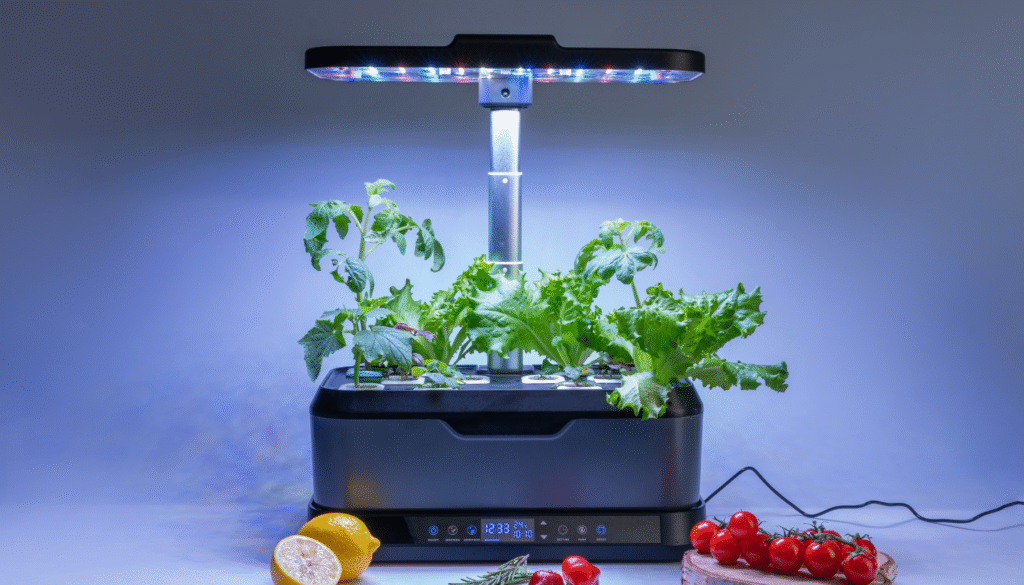Growing your own food isn’t just for people with big backyards anymore. With modern technology and smart solutions, even a small apartment can become a productive, beautiful, and self-sufficient green space. Whether you want fresh herbs, leafy greens, or compact vegetables, an indoor smart garden is an excellent way to live healthier, save money, and reduce your environmental footprint.
This guide will walk you through exactly how to set up your own intelligent indoor garden, even with limited space. From choosing the right plants to using AI-powered devices, here’s how to make it work—step by step.
Why Start an Indoor Smart Garden?
Before we get into the “how,” let’s look at the “why.”
- ✅ Fresh, chemical-free food at your fingertips
- ✅ Save money on herbs and greens that often spoil quickly
- ✅ Stress relief from daily contact with nature
- ✅ Better air quality inside your home
- ✅ An eco-conscious lifestyle, even in the city
With indoor gardening, you grow what you eat — and you know exactly what’s in it.
Step 1: Choose the Right Location
Even a windowsill or a corner shelf can become your green oasis. Here’s what to consider:
- Natural Light: South-facing windows are best, but artificial light works too.
- Ventilation: Good airflow prevents mold and pests.
- Humidity Control: Bathrooms and kitchens often have higher humidity—great for basil and mint.
- Accessibility: Make sure it’s easy to water and harvest your plants daily.
If your space lacks natural light, don’t worry—just move to the next step.
Step 2: Use Smart Lighting
Plants need light to grow. If you’re indoors, LED grow lights are your best friend. Here’s why:
- Mimic natural sunlight
- Use very little electricity
- Can be automated with smart plugs or timers
👉 Smart tip: Look for full-spectrum grow lights with adjustable intensity. Some high-end models even have apps that control the light cycle based on plant type.
Recommended Product: [Spider Farmer SF1000 Grow Light] or [GE Full Spectrum LED Grow Bulbs]
Step 3: Add Automation and Smart Sensors
Here’s where the tech gets fun—and helpful.
- Smart Watering Systems: Self-watering planters or drip irrigation kits with timers take the guesswork out of watering.
- Soil Moisture Sensors: These sensors monitor when your plant actually needs water (no more overwatering).
- Climate Monitors: Track temperature and humidity levels with Bluetooth-enabled devices and apps.
You can even use apps like “Planta” or “Gardenize” to track plant growth, receive watering reminders, and get AI-based plant care tips.
Step 4: Pick the Best Plants for Indoors
Stick with plants that thrive in containers and don’t require deep soil or direct sun.
Easy herbs:
- Basil
- Parsley
- Mint
- Cilantro
- Chives
Leafy greens:
- Spinach
- Arugula
- Lettuce
- Kale
- Swiss chard
Compact veggies:
- Cherry tomatoes (dwarf varieties)
- Radishes
- Microgreens
- Peppers (mini bell or Thai chili)
👉 Pro tip: Combine herbs and greens in a vertical garden or stackable planter to save space.
Step 5: Choose the Right Tools & Setup
Here’s what you’ll need for a basic but high-functioning smart garden:
| Item | Description | Estimated Cost |
|---|---|---|
| Smart grow lights | Full-spectrum LED with timer or app control | $25–$80 |
| Indoor planter or hydroponic kit | Soil-based or soilless growing system | $30–$150 |
| Moisture/temperature sensors | For data-driven care | $10–$50 |
| Seeds or seedlings | Choose organic or heirloom when possible | $5–$20 |
| Smart power strip | To automate your lighting and watering | $20–$40 |
Total setup cost: From $90 to $300, depending on how advanced you go.
Bonus: Can You Save or Make Money with It?
Absolutely.
- You can save up to $30/month by growing your own herbs and greens.
- Avoid food waste from buying bunches that spoil in the fridge.
- Some people even sell microgreens or herb bundles locally for extra income.
Start with saving, and as your garden grows, so does the opportunity to scale it into a side hustle.
Final Thoughts: Smart Gardening Is the Future of Urban Living
You don’t need a backyard or even a balcony to enjoy the benefits of growing your own food. With smart devices and thoughtful setup, your apartment can become a little ecosystem of wellness, sustainability, and flavor.
Whether you’re doing it for your health, your budget, or just for the joy of watching things grow, a smart indoor garden is one of the most rewarding things you can build for yourself.
Ready to take the first step? Start with a pot of basil, a grow light, and a little curiosity. Your future salad will thank you.



